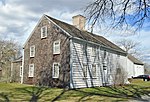Stone House Inn
Buildings and structures in Little Compton, Rhode IslandHouses in Newport County, Rhode IslandHouses on the National Register of Historic Places in Rhode IslandNational Register of Historic Places in Newport County, Rhode Island

The Stone House Inn, also known as the David Sisson House, located at 122 Sakonnet Point Road in Little Compton, Rhode Island, is a large four-story fieldstone residence – built in 1854 for David Sisson, a Providence-based industrialist – and its associated c.1886 barn. The structures sit on 2 acres (0.81 ha) of land overlooking Round Pond to the south, with a view of the Sakonnet River and Sakonnet Harbor to the west. When the house was completed, it was the largest single-family dwelling in that region and the only one built of stone.The building was listed on the National Register of Historic Places in 2008.
Excerpt from the Wikipedia article Stone House Inn (License: CC BY-SA 3.0, Authors, Images).Stone House Inn
Sakonnet Point Road,
Geographical coordinates (GPS) Address Nearby Places Show on map
Geographical coordinates (GPS)
| Latitude | Longitude |
|---|---|
| N 41.466111111111 ° | E -71.186388888889 ° |
Address
Sakonnet Point Road 124
02837
Rhode Island, United States
Open on Google Maps










